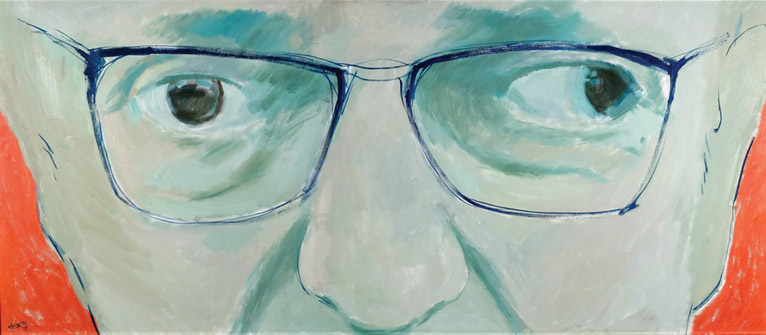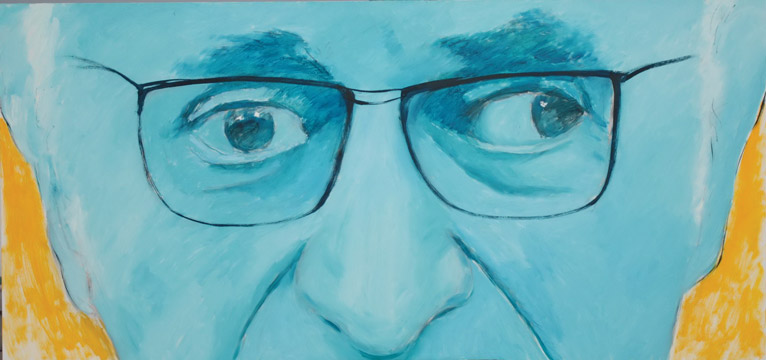ZHONG MING’S HE IS HIMSELF—SARTRE
| December 1, 2010 | Post In LEAP 6

Minsheng Art Museum’s inaugural exhibition, “30 Years of Chinese Contemporary Art,” which opened this past April in Shanghai, used the medium of painting as a tool for combing through the whole of artistic development in China. Hung right at the entrance to the exhibition was an iconic canvas by Zhong Ming, He is Himself—Sartre.
While the image appears in nearly every history of contemporary Chinese art, the details surrounding it and its maker have faded. But the fact is that once upon a time, He is Himself—Sartre sat at the center of a major controversy. The piece was first shown thirty years ago, as part of a Beijing Oil Painters Association exhibition at the National Art Museum of China. Although audience turnout for the show was large and most visitors took notice of the piece, many didn’t understand it. For those living in the initial years of the reform era, the only things that should be painted were still Chairman Mao, workers, peasants or soldiers. A figure of a foreigner and a name resonant with “self-expression” were enough to overturn the philosophy of the art world at the time.
The editor-in-chief of Meishu felt that this overturning, this invalidation, had to be discussed. He recommended that Zhong Ming write a letter in response to public uncertainty. And so came to be “Starting from Painting Sartre—On Self-Expressionism in Painting,” which set off an entire theoretical debate about the role of the artistic self in creative practice. Published in the February 1981 issue, the article immediately caused heated dispute over “whether or not painters should have personalities.” It’s possible that Zhong himself didn’t foresee the storm to which his painting and article would later give rise.

In 1980, China was swamped with new trends and ideas, as new translations of Western philosophy came into circulation among artists and intellectuals. Zhong Ming was in his early thirties and, like most people his age, held a great curiosity, particularly for philosophy. Especially interested in Sartre and his existentialism, Zhong read a great number of his writings. On April 15, 1980, Sartre passed away. The departure of his idol jump-started Zhong’s desire to paint a portrait. Yet in his planning, Zhong encountered a problem: how would he portray Sartre’s lazy left eye? His admiration for the man prevented him from showing the lazy eye directly. Yet, very few people then knew what Sartre actually looked like, and he couldn’t very well mislead people with false appearances. So Zhong chose to paint Sartre in the lower right corner of a horizontal composition, and paint the entire thing to look like a block print, with a shadow conveniently blocking this flaw. Zhong’s ornamental flourishes remain faithful to the philosopher’s true appearance, hence the title, He is Himself—Sartre, which picks up the idea from Sartre’s 1946 lecture “Existentialism is a Humanism,” that “Man is nothing else but that which he makes of himself.”
Zhong Ming was an instant celebrity. Where common sense would say he should have taken the opportunity to paint more, he decided to go abroad and study cinema two years later. Over the more than twenty years he spent studying film, music and photography in England, he never gave up painting. Many times he had exhibitions in London. When he returned to China in 1998, Zhong began to work at Shanghai Television, taking on directorial roles for television and film. Afterwards he began to work in television drama production at CCTV. Virtually no one around him knew of his background as a painter. He kept relatively undercover until 2005, when a friend working at the Shanghai Art Museum discovered that he was the same Zhong Ming who painted Sartre, and others slowly began to recall the Zhong Ming of yesteryear. The year 2005 also happened to mark the twenty-fifth anniversary of Sartre’s death and the centennial of his birth. Fortuitously, then, Zhong commenced painting anew with The End of Philosophy—Sartre, which boasted the same horizontal composition: the same 16:9 widescreen aspect ratio that is used in film. Together with the work from more than two decades before, it was featured in the exhibition “Painting Sartre Again, 25 Years Later” at Shanghai Art Museum. Up until now, Zhong has only painted Sartre one other time, in April of 2008. The work was sold at a solo exhibition of his in New York.
Today Zhong Ming spends his time between China and England, concentrating on his work. Although once again people are bringing up his name in conversation, Zhong says that he feels free and at ease. Occasionally he returns to Beijing, where he lived since youth, and where he finds happiness in seeing old friends. But no matter where he goes, he always carries a sketchbook with him. He’s gotten used to documenting things with the paintbrush. That’s what Zhong Ming has made of himself.


